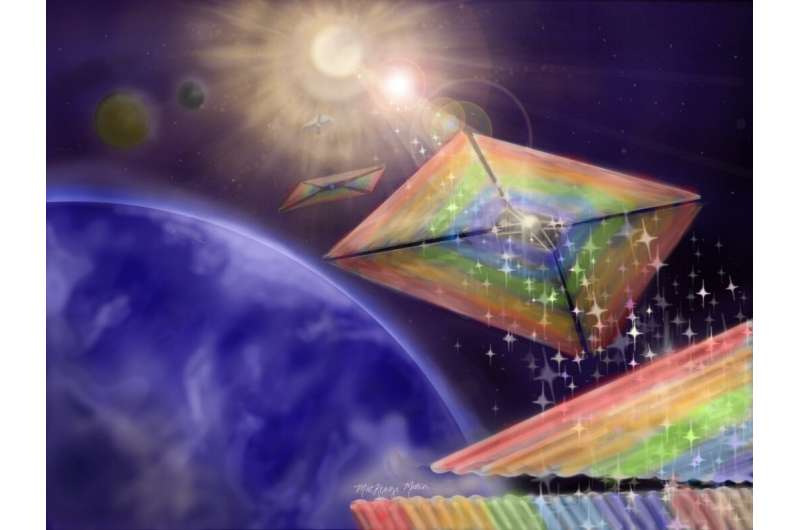
As NASA’s exploration continues to thrust boundaries, a new photo voltaic sail concept chosen by the agency for improvement toward a demonstration mission could have science to new places.
The Diffractive Photo voltaic Sailing undertaking was picked for Section III analyze below the NASA Revolutionary Highly developed Principles (NIAC) method. Period III aims to strategically transition NIAC ideas with the maximum prospective effects for NASA, other governing administration companies, or professional partners.
“As we undertaking farther out into the cosmos than at any time in advance of, we are going to need to have revolutionary, cutting-edge technologies to generate our missions,” said NASA Administrator Monthly bill Nelson. “The NASA Innovative Highly developed Principles application assists to unlock visionary ideas—like novel photo voltaic sails—and deliver them nearer to actuality.”
Like a sailboat employing wind to cross the ocean, solar sails use the strain exerted by sunlight to propel a craft by way of area. Existing reflective photo voltaic sail models are commonly really significant and incredibly skinny, and they are restricted by the course of the sunlight, forcing tradeoffs concerning energy and navigation. Diffractive lightsails would use modest gratings embedded in skinny films to choose edge of a property of gentle identified as diffraction, which causes gentle to distribute out when it passes by way of a slender opening. This would allow the spacecraft to make much more effective use of daylight without sacrificing maneuverability.
“Checking out the universe usually means we need new instruments, new tips, and new means of heading locations,” reported Jim Reuter, affiliate administrator for NASA’s Place Technology Mission Directorate (STMD) at NASA Headquarters in Washington. “Our target is to invest in individuals technologies through their lifecycle to help a robust ecosystem of innovation.”
https://www.youtube.com/check out?v=lc9KlJFX8Us
The new Section III award will give the research team $2 million over two decades to continue know-how enhancement in preparing for a potential foreseeable future demonstration mission. The job is led by Amber Dubill of the Johns Hopkins College Used Physics Laboratory in Laurel, Maryland.
“NIAC allows us to foster some of the most imaginative engineering concepts in aerospace,” mentioned Mike LaPointe, acting method govt for the NIAC plan at NASA Headquarters. “Our target is to modify the attainable, and diffractive solar sailing claims to do just that for a amount of exciting new mission apps.”
Diffractive lightsailing would increase photo voltaic sail capacity beyond what’s feasible with missions in growth right now. The project is led by Amber Dubill of the Johns Hopkins University Applied Physics Laboratory in Laurel, Maryland. The feasibility of the idea was formerly examined underneath NIAC’s Stage I and Period II awards, led by Dr. Grover Swartzlander of Rochester Institute of Technological know-how in New York, who carries on as a co-investigator on the venture. Les Johnson, lead for two of NASA’s upcoming photo voltaic sail missions at NASA’s Marshall House Flight Center in Huntsville, Alabama, also is a co-investigator. Under the previously awards, the team made, made, and examined distinct styles of diffractive sail resources conducted experiments and intended new navigation and control strategies for a likely diffractive lightsail mission orbiting the Sun’s poles.
Operate under Section III will optimize the sail substance and carry out ground assessments in help of this conceptual photo voltaic mission. Orbits passing more than the Sun’s north and south poles are complicated to reach using common spacecraft propulsion. Light-weight diffractive lightsails, propelled by the frequent strain of daylight, could place a constellation of science spacecraft in orbit close to the Sun’s poles to progress our understanding of the Sunlight and strengthen our space climate forecasting capabilities.
“Diffractive solar sailing is a fashionable take on the many years aged eyesight of lightsails. When this know-how can increase a multitude of mission architectures, it is poised to very influence the heliophysics community’s require for unique solar observation capabilities,” explained Dubill. “With our team’s blended skills in optics, aerospace, standard solar sailing, and metamaterials, we hope to enable scientists to see the Sunshine as hardly ever ahead of.”
NASA selects early-phase engineering ideas for new, continued study
Quotation:
NASA-supported photo voltaic sail could consider science to new heights (2022, Might 25)
retrieved 30 May well 2022
from https://phys.org/information/2022-05-nasa-supported-photo voltaic-science-heights.html
This document is subject to copyright. Apart from any truthful dealing for the reason of non-public review or investigate, no
component may well be reproduced without having the composed permission. The material is furnished for facts applications only.
